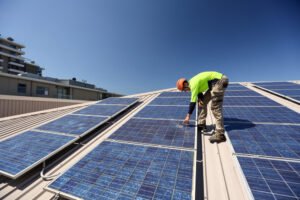Table of Contents
ToggleAre you tired of the ever-increasing energy bills in Perth? You’re not alone. With energy costs on the rise, households are seeking sustainable solutions to slash their expenses. In this article, we’ll delve into the pressing issue of rising energy costs and explore how solar power can be a game-changer for your budget. Discover the potential of solar panel cost savings and the benefits of embracing solar power systems. Let’s embark on a journey to not only reduce your carbon footprint but also to save significantly on your energy bills. Join the solar revolution in Perth!
Importance of Exploring Alternative Energy Sources
As the world’s dependence on fossil fuels continues to grow, the search for sustainable and environmentally friendly alternatives becomes increasingly urgent. The impact of climate change is becoming more evident with each passing year, and the need to transition to clean energy sources is no longer a matter of debate but a necessity. This is where exploring alternative energy sources like solar, wind, geothermal, and hydro power comes into play.
Solar power As a Viable Solution in Perth
Perth, the capital of Western Australia, boasts an abundance of sunshine, making it an ideal location for harnessing the power of the sun. Solar power offers a multitude of benefits for both Perth residents and the environment, making it a viable and attractive alternative to traditional energy sources.
Solar power savings
Reduced energy bills: By generating your electricity using solar panels, you can significantly reduce your reliance on the grid, leading to lower electricity bills. The amount of savings will vary depending on the size of your system and your energy consumption, but the potential for cost reduction is undeniable.
Increased property value: Homes with solar panels are often seen as more desirable by potential buyers, and studies have shown that they can command a higher price in the market. This is due to the perceived energy savings and environmental benefits associated with solar power.
Government incentives: Many governments offer financial incentives to encourage the adoption of solar power. These incentives can take the form of tax credits, rebates, or feed-in tariffs, making the switch to solar even more financially attractive.
Environmental benefits of solar energy
Reduced greenhouse gas emissions: Solar power is a clean and renewable energy source that does not produce greenhouse gases during operation. This makes it a crucial tool in the fight against climate change and can help mitigate the harmful effects of global warming.
Improved air quality: Solar power generation does not emit air pollutants, such as smog and particulate matter, which can contribute to respiratory problems and other health issues. This can lead to improved air quality and a healthier environment for Perth residents.
Reduced water usage: Unlike traditional power plants, which require large amounts of water for cooling purposes, solar power generation does not have a significant water footprint. This is especially important in a region like Perth, which is prone to droughts.
Understanding Solar Power: Shining a Light on Your Energy Future
Harnessing the sun’s power has captivated humanity for centuries, and with modern technology, we’ve finally cracked the code! Solar power offers a clean, renewable solution to our energy needs, and understanding its basics can illuminate a brighter future for your home and the planet.
How Solar Panels Work:
Imagine tiny superheroes on your roof, soaking up the sun’s rays and converting them into electricity. That’s essentially what solar panels do! Made from semiconductor materials like silicon, they absorb photons (light particles) and knock electrons loose, setting off a chain reaction that generates electricity. This direct current (DC) electricity flows through an inverter, transforming it into usable alternating current (AC) for your home appliances.
Advantages of Solar Power:
The benefits of solar power go far beyond simply keeping the lights on. Here are a few key advantages:
Renewable Energy Source: Unlike fossil fuels, which are finite and contribute to climate change, solar power is constantly replenished by the sun. It’s a reliable source of energy that won’t run out, ensuring a sustainable future for generations to come.
Environmentally Friendly: Solar power generation produces zero greenhouse gas emissions or air pollution, making it a clean and responsible choice for the planet. By switching to solar, you’re actively contributing to a healthier environment and combating climate change.
Cost-Effectiveness in the Long Run: While the initial investment in solar panels might seem daunting, the long-term savings are undeniable. As you generate electricity, your dependence on the grid and its ever-increasing prices decreases. Moreover, government incentives and net metering programs often offset the upfront costs, making solar power a wise financial investment.
Economic Impact of Solar Power: The solar industry is booming, creating new jobs in manufacturing, installation, and maintenance. By choosing solar, you’re not just benefiting your home but also contributing to a thriving green economy and creating more sustainable employment opportunities.
Perth: Sun-Kissed and Solar-Ready
Perth, nestled on Australia’s sunny west coast, is a solar paradise waiting to be tapped. With an average of over 8 hours of sunshine per day and intense solar radiation, it’s no surprise that Perth boasts some of the highest solar potential in the country.
Climate Suitability: Perth’s dry, warm climate with minimal cloud cover provides ideal conditions for solar panels to convert sunlight into electricity efficiently. This consistent sunshine throughout the year ensures reliable solar energy production, unlike regions with harsher winters or frequent rain.
Financial Benefits: Perth residents and businesses can reap significant financial rewards from going solar. Reduced reliance on the grid translates to lower electricity bills, with savings often exceeding 20-50% in the first year alone. Additionally, government incentives like feed-in tariffs offer extra income for excess solar energy exported back to the grid.
Beyond Savings: The benefits of solar power extend far beyond personal finances. By choosing solar, Perth residents are actively contributing to combating climate change. Solar energy generation produces zero greenhouse gas emissions or air pollution, making it a clean and sustainable alternative to fossil fuels.
Harnessing the Sun: How to Size Your Solar Power System
Before basking in the glow of solar independence, knowing your energy consumption is key. To size your system for optimal savings, let’s delve into the world of kilowatt-hours (kWh) and sun-powered potential.
Understanding Your Electricity Bills:
Your trusty monthly bill holds the first clue. Look for your total kWh usage over a year, ideally factoring in seasonal variations. This gives you a baseline understanding of your energy needs.
Assessing Peak Usage Times:
Do you crank up the AC in summer afternoons or become a Netflix champion after dark? Identifying peak usage times helps determine when your solar system needs to produce the most energy.
Sizing Your Solar Power System:
Now comes the fun part! Aim to offset your yearly kWh consumption with your solar system’s production. Divide your annual kWh usage by your peak sun hours in Perth (around 5) to estimate the kW capacity of your system. For example, 10,000 kWh / 5 × 1.15 EF = 2.3 kW system.
Factors Affecting System Size:
Remember, this is just a starting point. Several factors can tweak your system size:
Roof space: The available roof area dictates how many panels you can install.
Panel efficiency: Higher efficiency panels generate more power per square metre.
Battery storage: Want to use solar power at night? Battery storage adds capacity but increases costs.
Budget: System size directly impacts initial investment.
Choosing the Right Solar Panels: Power Up Your Perth Paradise
Harnessing Perth’s sunshine requires the perfect match: you and your ideal solar panels. But with a dazzling array of options, making the right choice can feel like navigating a solar eclipse. Fear not, sunseekers! This guide will illuminate the path to powering your home with confidence.
Types of Solar Panels:
Monocrystalline: These top-tier panels boast the highest efficiency (up to 22%) and sleek, black silicon cells but come at a premium price.
Polycrystalline: More affordable and slightly less efficient (16-19%), these panels feature a speckled blue appearance due to their multiple silicon crystals.
Thin-film: These lightweight, flexible panels are ideal for unconventional roof shapes but have lower efficiency (around 10%) and shorter lifespans.
Warranty and Durability:
Look for panels with at least a 10-year product warranty and a 25-year performance warranty. This ensures your investment is protected against manufacturing defects and guaranteed power output over time.
Efficiency Ratings:
The higher the efficiency rating, the more sunlight your panels convert into usable electricity. While higher efficiency panels initially cost more, they require fewer panels to generate the same amount of power, potentially saving you space and installation costs.
Beyond the Specs:
Remember, choosing solar panels is more than just ticking boxes. Consider factors like:
Brand reputation: Research the manufacturer’s track record for quality and customer service.
Aesthetics: Choose panels that complement your home’s style.
Local availability and support: Ensure you can easily access installation and maintenance services.
Soaking Up the Sun: Your Guide to a Smooth Solar Power Installation
Transitioning to solar power in Perth is an exciting step towards energy independence and environmental consciousness. But before you picture yourself basking in the glow of your self-generated electricity, there’s the not-so-glamorous but crucial step: installation. Fear not, sunseekers! This guide will illuminate the process and ensure your journey to solar success is smooth and hassle-free.
Hiring a Professional Installation Service Provider:
Finding the right installer is like unearthing the perfect hidden gem on a Perth beach. Do your research! Look for:
Licensing and certifications: Choose installers accredited by the Clean Energy Council or similar bodies.
Experience and track record: Ask for references and check online reviews.
Transparency and communication: Ensure they provide clear proposals, answer your questions, and involve you in the process.
Local understanding: Opt for installers familiar with Perth’s specific solar conditions and building regulations.
Steps Involved in the Installation Process:
Once you’ve found your solar soulmate, the installation dance begins:
Site assessment: The installer will evaluate your roof orientation, shading, and electrical infrastructure to determine the ideal system size and placement.
Permits and paperwork: Your installer will handle obtaining necessary permits and approvals from local authorities.
System design and equipment selection: Together, you’ll choose the perfect panels, inverter, and other components based on your needs and budget.
Installation: Brace yourself for some rooftop acrobatics! Trained professionals will securely mount the panels onto your roof.
Electrical connection: Your system will be seamlessly integrated into your home’s existing electrical wiring.
System inspection and commissioning: Qualified personnel will ensure everything is functioning optimally and ready to generate sunshine-powered electricity.
Monitoring and maintenance: Most installers offer monitoring systems and maintenance packages to keep your solar power plant humming happily.
Remember:
Timeline: The installation process typically takes a few days to a week, depending on your system size and complexity.
Costs: Factor in installation costs alongside equipment prices to get a complete picture of your investment. Don’t hesitate to compare quotes from multiple installers.
Financing options: Explore available financing options like loans or leases to make your solar dream reality.
Sun-Kissed Savings: Financing Your Solar Power System in Perth
Harnessing Perth’s sunshine for clean energy is an exciting step towards a brighter future. But let’s face it: the initial cost of a solar power system can seem daunting. Don’t let that shade your solar dreams! This guide will illuminate the various financing options and help you pave the way towards sun-powered savings.
Upfront Costs and Financing Options:
The upfront cost of a solar power system in Perth typically ranges from $5,000 to $15,000, depending on factors like system size, panel efficiency, and additional components. While the initial investment might seem significant, several financing options can make your solar journey more accessible:
Cash purchase: Paying upfront offers the advantage of immediate ownership and potential discounts.
Solar loans: Secure financing specifically designed for solar power systems, often with lower interest rates compared to traditional loans.
Leasing: Lease the solar panels instead of buying them, with lower upfront costs but no ownership benefits.
Power purchase agreements (PPAs): Pay a fixed monthly fee for the solar energy generated by the system without owning the equipment.
Return on Investment (ROI):
While the initial cost might seem high, investing in a solar power system offers significant long-term savings:
Reduced electricity bills: Generate your electricity and slash your dependence on the grid, potentially saving 20-50% or more on your energy bills over time.
Feed-in tariffs: Many states offer feed-in tariffs, where you can earn credits for the excess solar energy you export back to the grid.
Increased property value: Homes with solar panels often sell faster and for higher prices.
Calculating your ROI:
To estimate your specific ROI, consider factors like:
System cost and financing terms
Average electricity bills
Expected energy production based on your system size and Perth’s sunshine
Available government incentives and rebates
Keeping Your Sunshine Bright: Maintenance and Care for Your Perth Solar Power System
Harnessing Perth’s sunshine for your clean energy is an investment worth cherishing. But just like any prize possession, it needs a little TLC to keep it humming happily. This guide will illuminate the essential maintenance steps for your solar power system, ensuring it shines bright for years to come.
Cleaning Solar Panels:
Perth’s beautiful sunshine might be your panels’ best friend, but dust, leaves, and bird droppings can cast a shadow on their efficiency. Regular cleaning will keep your system performing at its peak:
Frequency: Twice a year is ideal, especially after windy or dusty periods.
Method: Opt for a gentle hose down or soft brush with soapy water. Avoid harsh chemicals or abrasive scrubbers.
Timing: Do it early in the morning or late in the afternoon to avoid heat stress on the panels.
Monitoring System Performance:
Don’t just watch the sunrise; watch your system, too! Most inverters come with monitoring systems that track your energy production. Keep an eye on:
Daily and monthly energy output: Compare it to expected production based on your system size and weather conditions.
Overall system health: Look for alerts or indicators of any potential issues.
Troubleshooting Common Issues:
Even the sunniest days can have a few clouds. If you notice a dip in performance, don’t panic! Common issues are often easily resolved:
Shading: Ensure no trees or structures block sunlight from your panels.
Loose connections: Check cable connections for any signs of wear or damage.
Inverter faults: Most inverters have diagnostic tools to help identify potential issues.
For any major concerns or troubleshooting beyond your expertise, don’t hesitate to contact West Coast Solar. Remember, the sun is always shining on your investment, so make sure it shines bright with proper maintenance!
Solar panels convert sunlight into electricity, which your home can use directly. This reduces your reliance on the grid, leading to lower electricity bills. Savings vary depending on your system size, energy consumption, and electricity rates but typically range from 20-50% or more annually.
Several factors influence your system’s efficiency:
- Panel efficiency: Higher efficiency panels convert more sunlight into electricity, requiring fewer panels to generate the same amount of power.
- Sun exposure: South-facing roofs with minimal shading receive the most sun and maximise efficiency.
- Tilt and orientation: Optimally angled panels capture more sunlight throughout the day.
- Inverters: Choose high-quality inverters to minimise conversion losses from DC to AC electricity.
The payback time is the period it takes for the energy savings to offset the initial cost of your system. It typically ranges from 5 to 10 years in Perth, depending on factors like system size, financing options, and electricity rates. Remember, after the payback period, you’re essentially enjoying free electricity from the sun!
Yes, solar panels can still generate electricity on cloudy days, though not as efficiently as on sunny days. They absorb light even through thin clouds, and Perth’s abundant sunshine ensures even cloudy days contribute to your overall energy production.

Wade Rose
Wade Rose, an accomplished electrician with a career spanning from the age of 18, has smoothly navigated the dynamic terrain of the energy sector. In 2008, he made a notable shift towards renewable energy, and by 2015, Wade's focus had firmly turned towards solar technologies. Over the years, he has refined his expertise in Residential and Commercial Photovoltaic (PV) and Battery systems, significantly advancing sustainable energy solutions. Wade's dedication to innovation and excellence has garnered recognition from colleagues and customers. Beyond his professional endeavours, he enjoys riding motorcycles, boat rides, camping, fishing, exploring Australia and cherishing moments with his family. Wade Rose brings a wealth of experience and a genuine passion for sustainable energy to the forefront, making him an invaluable leader for navigating the complexities of EAT implementation.



